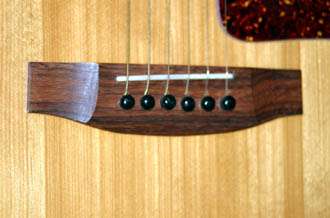Flat top guitar
A flat top guitar is a type of guitar body model which has a flat top (as opposed to archtop). The term "flat top" is usually used to refer to the most popular type of steel-string acoustic guitars;[1] however, electric guitars such as the Fender Stratocaster, the Fender Telecaster and the Gibson Les Paul Junior and Special can be described as "flat top".
Sound generation
-

Flat top bridge
String vibrations are lateral. This vibration is translated to a push/pull force on the bridge, transferring to the soundboard (top) which then moves in/outward similar to a speaker membrane.
String vibrations cause minute length variations, or stretching. With varying degrees of stretching, the tension varies. This can be thought of as longitudinal vibration. The strings are anchored to the bridge and the pull of the strings is directed to the side of the anchoring point. This creates a torsional force deforming the soundboard. When tension increases, it will create a belly below the bridge (away from the strings) and a dip above the bridge (under the strings). This deformation creates more complex sound waves than the push/pull action.
This is different from an archtop instrument, where both longitudinal and lateral vibrations are translated to variation in the bridge's pushing down on the soundboard. This gives the flat top a "richer" timbre, where the archtop sounds "cleaner". With few additional instruments, the rich sound of a flat top guitar is often preferred, while in larger orchestras the cleaner sound of the archtop is more suitable.